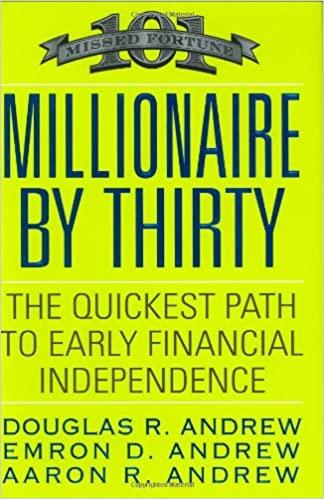Question
True / False Questions 18. Compound interest pays interest for each time period on the original investment plus the accumulated interest. True False 19. For
True / False Questions
18. Compound interest pays interest for each time period on the original investment plus the
accumulated interest.
True False
19. For a given amount, the lower the discount rate, the less the present value.
True False
20. Comparing the values of undiscounted cash flows is analogous to comparing apples to oranges.
True False
21. Converting an annuity to an annuity due decreases the present value.
True False
22. Nominal dollars refer to the amount of purchasing power.
True False
23. An effective annual rate must be greater than an annual percentage rate.
True False
24. A dollar tomorrow is worth more than a dollar today.
True False
25. You should never compare cash flows occurring at different times without first discounting them
to a common date.
True False
26. The Excel function for present value is PV (rate, nper, pmt, FV).
True False
27. An annuity due must have a present value at least as large as an equivalent ordinary annuity.
True False
Multiple Choice Questions
28. What is the future value of $10,000 on deposit for 5 years at 6% simple interest?
A. $7,472.58
B. $10,303.62
C. $13,000.00
D. $13,382.26
29. Under which of the following conditions will a future value calculated with simple interest exceed a future value calculated with compound interest at the same rate?
A. The interest rate is very high.
B. The investment period is very long.
C. The compounding is annually.
D. This is not possible with positive interest rates.
30. How much interest is earned in just the third year on a $1,000 deposit that earns 7% interest compounded annually?
A. $70.00
B. $80.14
C. $105.62
D. $140.00
31. Assume the total expense for your current year in college equals $20,000. How much would your parents have needed to invest 21 years ago in an account paying 8% compounded annually to cover this amount?
A. $952.46
B. $1,600.00
C. $1,728.08
D. $3,973.11
32. How long must one wait (to the nearest year) for an initial investment of $1,000 to triple in value if the investment earns 8% compounded annually?
A. 9.81 years
B. 14.27 years
C. 22.01 years
D. 25.00 years
33. Given a set future value, which of the following will contribute to a lower present value?
A. Higher discount rate
B. Fewer time periods
C. Less frequent discounting
D. Lower discount factor
34. If the future value of an annuity due is $25,000 and $24,000 is the future value of an ordinary annuity that is otherwise similar to the annuity due, what is the implied discount rate?
A. 1.04%
B. 4.17%
C. 5.00%
D. 8.19%
35. How much must be invested today in order to generate a 5-year annuity of $1,000 per year, with the first payment 1 year from today, at an interest rate of 12%?
A. $3,604.78
B. $3,746.25
C. $4,037.35
D. $4,604.78
36. You will be receiving cash flows of: $1,000 today, $2,000 at end of year 1, $4,000 at end of year 3, and $6,000 at end of year 5. What is the present value of these cash flows at an interest rate of 7%?
A. $9,731.13
B. $10,412.27
C. $10,524.08
D. $11,524.91
37. A perpetuity of $5,000 per year beginning today is said to offer a 15% interest rate. What is its present value?
A. $33,333.33
B. $37,681.16
C. $38,333.33
D. $65,217.39
38. A corporation has promised to pay $1,000 20 years from today for each bond sold now. No interest will be paid on the bonds during the 20 years, and the bonds are discounted at an interest rate of 7%, compounded semiannually. Approximately how much should an investor pay for each bond?
A. $70.00
B. $252.57
C. $629.56
D. $857.43
39. Your retirement account has a current balance of $50,000. What interest rate would need to be earned in order to accumulate a total of $1,000,000 in 30 years, by adding $6,000 annually?
A. 5.02%
B. 7.24%
C. 9.80%
D. 10.07%
40. The present value of an annuity stream of $100 per year is $614 when valued at a 10% rate. By approximately how much would the value change if these were annuities due?
A. $10
B. $61.40
C. $10 Number of years in annuity stream
D. $6.14 Number of years in annuity stream
41. If inflation in Wonderland averaged about 3% per month in 2013, what was the annual rate of inflation?
A. 36.00%
B. 42.58%
C. 40.09%
D. 41.27%
42. Approximately how much should be accumulated by the beginning of retirement to provide a $2,500 monthly check that will last for 25 years, during which time the fund will earn 6% interest with monthly compounding?
A. $361,526.14
B. $388,017.16
C. $402,766.67
D. $414,008.24
43. With $1.5 million in an account expected to earn 8% annually over the retiree's 30 years of life expectancy, what annual annuity can be withdrawn, beginning today?
A. $112,148.50
B. $120,000.00
C. $123,371.44
D. $133,241.15
44. Real interest rates:
A. always exceed inflation rates.
B. can decline to zero but no lower.
C. can be negative, zero, or positive.
D. traditionally exceed nominal rates.
And if possible explain the problems with numbers.
Step by Step Solution
There are 3 Steps involved in it
Step: 1

Get Instant Access to Expert-Tailored Solutions
See step-by-step solutions with expert insights and AI powered tools for academic success
Step: 2

Step: 3

Ace Your Homework with AI
Get the answers you need in no time with our AI-driven, step-by-step assistance
Get Started


